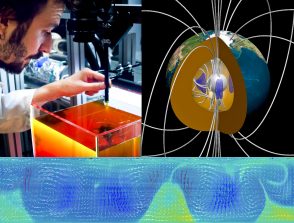Thermal evolution of a primitive magma ocean in interaction with its outgassing atmosphere: implication for the primitive surface conditions and the evolution of rocky planets
01/06/2023
IPGP - Îlot Cuvier
14:00
Séminaires Dynamique des fluides géologiques
Salle 310
Helene Massol
Universite Paris-Saclay
We simulate the secular convective cooling of a 1-D magma ocean (MO) in interaction with its outgassing atmosphere. The heat transfer in the atmosphere is computed either using the grey approximation or using a k-correlated method. A first rapid cooling stage, where efficient MO cooling and degassing take place, producing the atmosphere, is followed by a second quasi steady state where the heat flux balance is dominated by the solar flux. The end of the rapid cooling stage (ERCS) is reached when the mantle heat flux becomes negligible compared to the absorbed solar flux. We recall the definition of what we called ERCS and discuss the other criteria used by different authors to define the end of the magma ocean stage. The resulting surface conditions at ERCS, including water ocean’s formation,
strongly depend both on the initial volatile content and solar distance D. For D>DC, the “critical distance,” the volatile content controls water condensation and a new scaling law is derived for the water condensation limit. Three types of surfaces are identified: (i) solid surface and water ocean, (ii) solid surface and (iii) partially melted surface. The likelihood of water ocean formation is more important than previously thought and for instance, depending on its cloud
cover and resulting albedo, 0.13 Earth ocean mass might be sufficient to form a water ocean on early Venus. I will discuss our new results in view of other recent models. This discussion allows evaluating the importance of the individual processes involved. We then intend to use our results to discuss the early evolution of Venus as well as the state of the surface of different exoplanets and show that liquid water at the surface of Trappist 1e and 1f is indeed likely.





